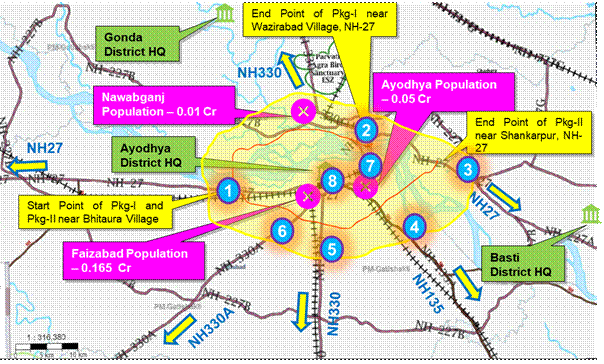PM GatiShakti Ignites Momentum for Ayodhya Bypass Project to Boost Connectivity and Economic Growth

In a significant stride towards comprehensive infrastructure development, the Prime Minister’s ambitious initiative, GatiShakti, has catalyzed the project planning and implementation of the Ayodhya Bypass Project. Designed to enhance economic, social, and logistics connectivity across multiple districts, the Ayodhya Bypass Project is poised to alleviate traffic congestion, spur economic growth, and foster seamless travel in the region.
Over the past two years, GatiShakti has been pivotal in orchestrating 64 Network Planning Group (NPG) meetings, meticulously evaluating the socio-economic development of over 131 infrastructure projects. Among these, the Ayodhya Bypass Project emerged as a critical infrastructure endeavor, garnering attention during the 52nd NPG meeting.
The Ayodhya Bypass Project, covering a total length of 67.57 kilometers, is a Greenfield initiative encompassing the construction of 4/6 Lane Northern Ayodhya Bypass (35.40 kms) and Southern Ayodhya Bypass (32.172 kms). Spanning key districts like Lucknow, Basti, and Gonda, this project is strategically positioned to improve connectivity to economic, social, and logistics nodes, including tourist and pilgrim sites, across the region.
Ayodhya, strategically nestled between the economic hubs of Lucknow and Gorakhpur, plays a pivotal role in facilitating the transit of major commodities such as leather, engineering goods, building materials, iron, and steel. The construction of this bypass route is poised to streamline freight flows, mitigate traffic congestion, and elevate the city’s overall infrastructure.
Anticipated to cater to a forecasted increase in passenger and freight vehicle movement, the Ayodhya Bypass is projected to witness exponential growth, handling around 89,023 movements in 2023 and an estimated 216,928 movements in 2033. This development is set to benefit eight influence areas around Ayodhya, fostering seamless movement of people and goods, and reducing travel time to critical national highways.
The Ayodhya Bypass Project aligns with the broader vision of enhancing multi-modality, integrating key infrastructure elements like Railway Stations (at Ayodhya Railway Station, Sohwal Railway Station, A N Dev Nagar Railway Station, and Ayodhya Cantt Railway Station) and the Ayodhya Airport. These integrations are poised to bolster regional connectivity and promote economic activities.
This visionary project is expected to complement and synergize with other proposed initiatives evaluated in NPG meetings, including the Prayagraj – Raibareili Project, Gorakhpur-Siliguri Corridor, and Gorakhpur-Bareilly Corridor. The holistic approach towards infrastructural development is aimed at creating a robust and interconnected network, facilitating economic growth and regional development.
Ayodhya’s regional significance extends beyond its cultural and historical importance. The recent inauguration of the Maharishi Valmiki International Airport in Ayodhya marked a pivotal moment, providing a convenient air travel option for visitors and connecting Ayodhya to the national and international transportation grid.
Moreover, the redevelopment of Ayodhya Dham Junction Railway Station, aligned with modern standards, is set to transform the rail infrastructure. The three-storied modern railway station building, equipped with modern features such as lifts, escalators, food plazas, shops for puja needs, cloakrooms, childcare rooms, and waiting halls, ensures a seamless travel experience for the increasing number of commuters.
Key Highlights of Redeveloped Ayodhya Dham Junction Railway Station:
- Modern Railway Station Building: A three-storied structure equipped with modern amenities.
- Accessibility for All: Ensuring inclusivity with a building designed to be accessible for all.
- Green Station Building: The station is certified by the Indian Green Building Council (IGBC) for its environmentally friendly features.
Major Commodities Passing Through Ayodhya:
- Manufacturing items (leather, textile, plastic & engineering goods)
- Building Materials
- Perishable groceries (Fish, dairy, fruits/vegetables)
- Others (Oil, Gas, Iron, Steel & Wood)
Efficiencies Generated from the Ayodhya Bypass Corridor:
- 5 Km Length Reduction: Providing peripheral connectivity to streamline transportation.
- 66.67% Travel Time Reduction: From 1.2 hours to 0.4 hours, ensuring faster and efficient travel.
- 250% Increment in Average Speed: Boosting speed from 40 km/hr. to 100 km/hr.
- 80 Lakh Person-days of Employment Generation: Contributing significantly to job creation.
- Environmental Impact:
- 50 lakh liters Fuel Reduction Annually: As the network provides peripheral connectivity.
- 1 Crore Kg Annually Reduction in Carbon Footprints: Achieved through increased speed.
- 20 Km Length: Utilizing recyclable/reusable material in construction.
The Ayodhya Bypass Project stands as a testament to India’s commitment to fostering development, connectivity, and sustainable practices. As the nation celebrates its 75th Republic Day, this transformative project represents a milestone in the journey towards a more connected, efficient, and environmentally conscious future.




